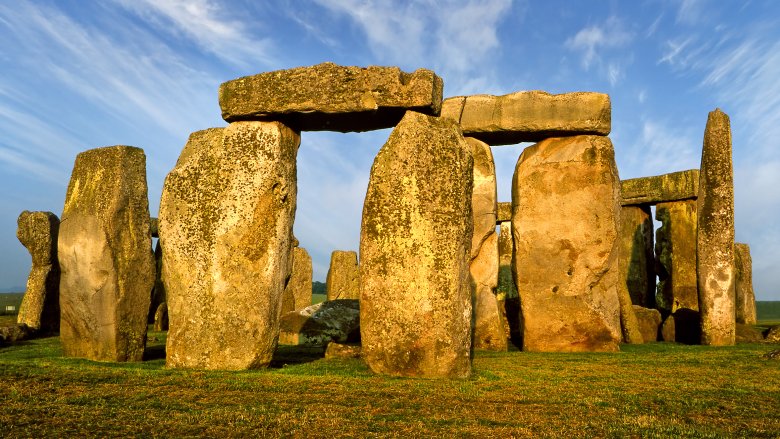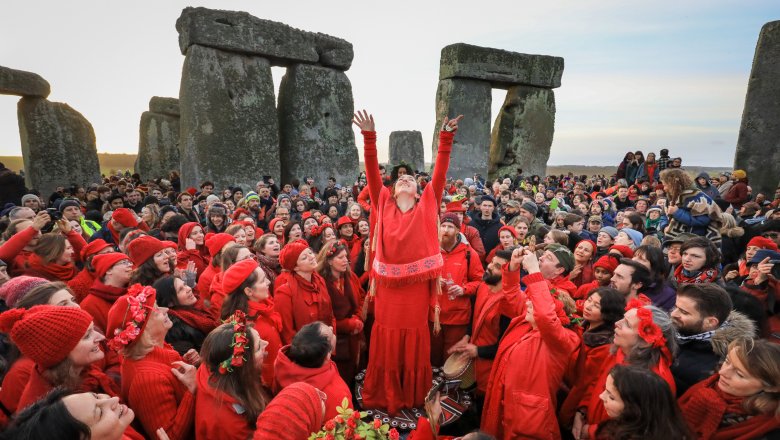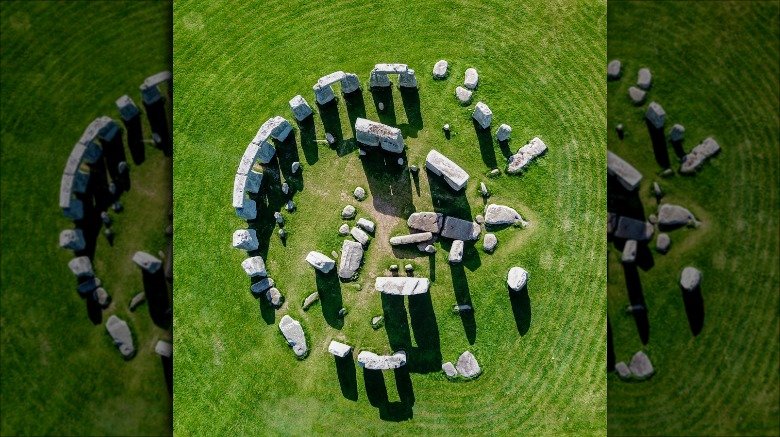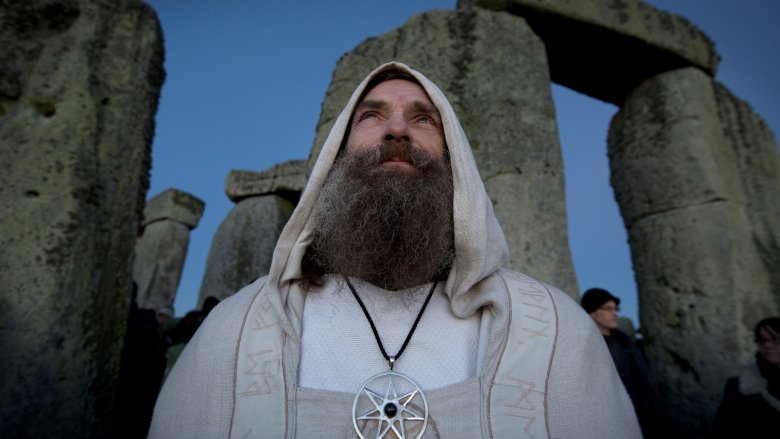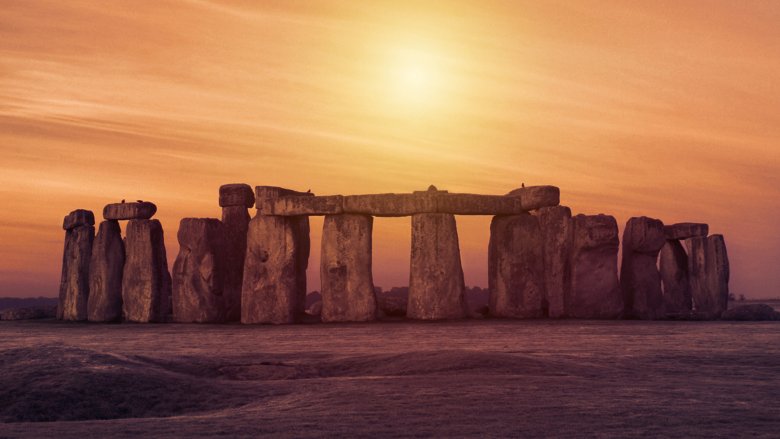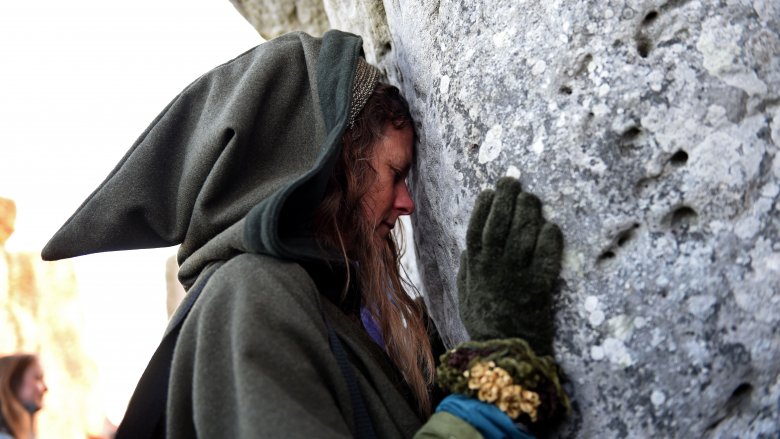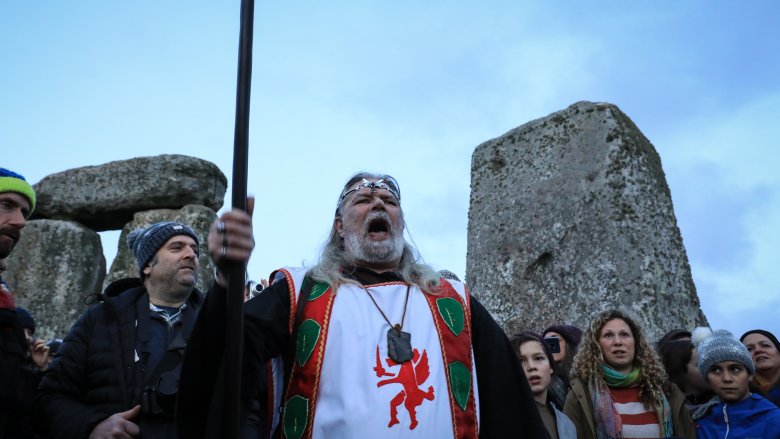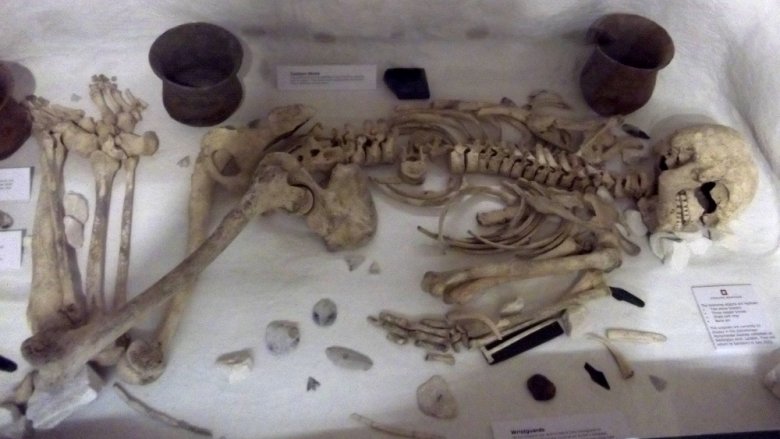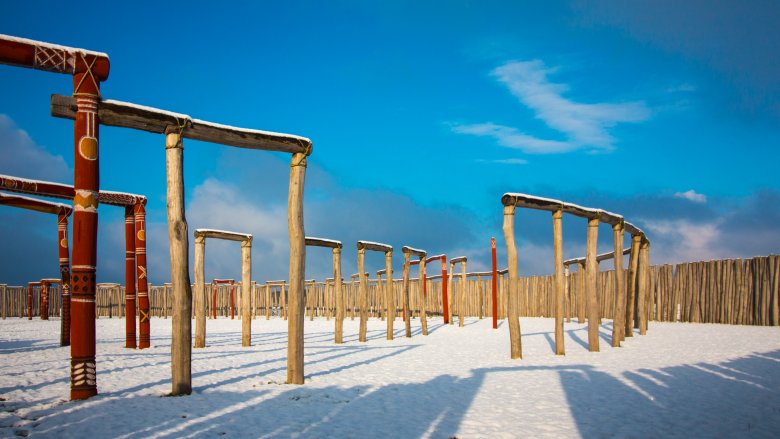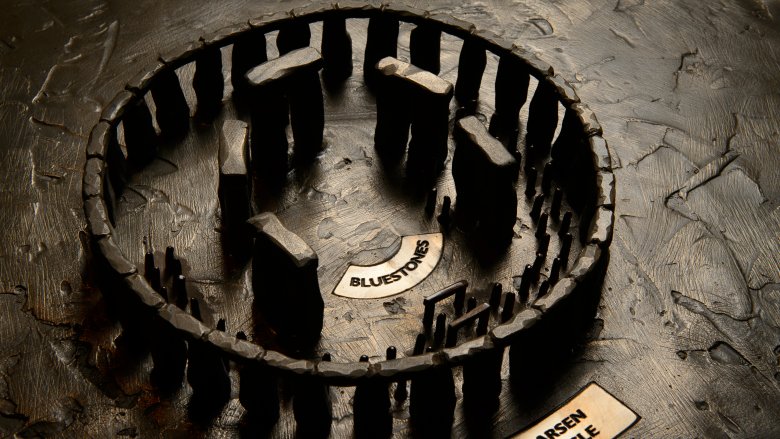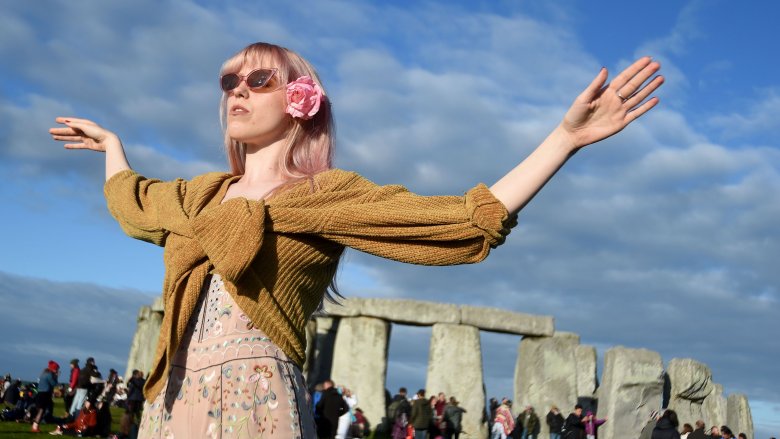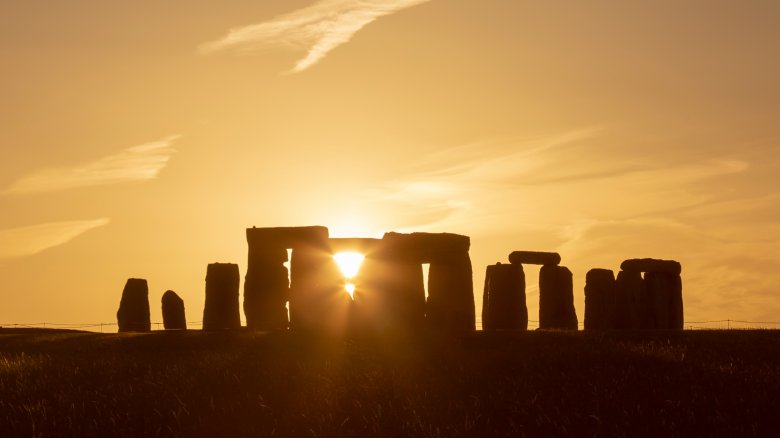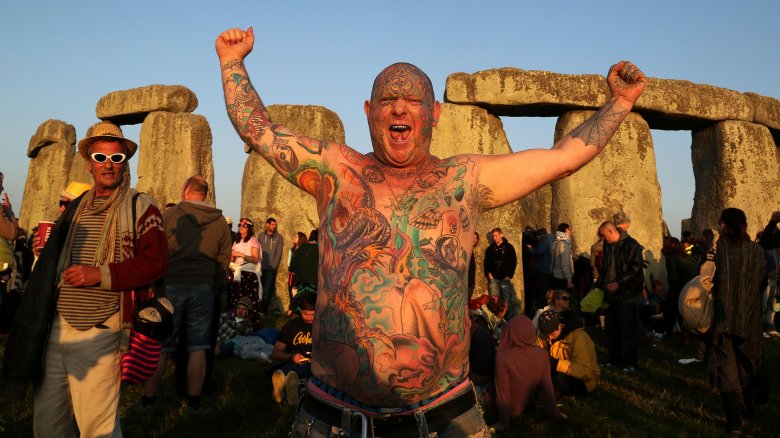The Untold Truth Of Stonehenge
Stonehenge, "where the dew drops cry and the cats meow," according to Spinal Tap. Of course, the band also said demons and banshees live there, so we should probably take their claims with a grain of salt and a barrel of laughs. Spinal Tap got one thing right about Stonehenge, though: "'Tis a magic place." Located in Wiltshire, England, this magic place has captured the imaginations of monarchs, scholars, and massive rock fans for centuries. In 1620 the Duke of Buckingham dug a hole there because his "intimate friend" King James I "expressed an interest in the stones." In 1872 Charles Darwin's son studied Stonehenge for clues about evolution. In the 1980s hippies shed blood just to get close to Stonehenge.
Even in the era of iPhones and Netflix these ancient stones continue to stoke our curiosity. Perhaps it's because we're still in the dark about basic details, like how and why people built it. Here we'll delve into various mysteries, histories, discoveries, theories, and conflicts surrounding the monument. So pour yourself a glass of dew drop tears and drink in the magic of Stonehenge.
How the henge did people move those stones?
Construction of Stonehenge occurred during the Stone Age between 4,000 and 5,000 years ago and took an estimated 1,500 years to complete, according to History. The structure's outer circle consists of large stones, known as sarsens, which measure up to 30 feet tall, per Live Science, and weigh an average of 25 tons, or roughly as much as four large Asian elephants. Sarsens also form a U shape inside the circle. These elephantine slabs are believed to have come from Marlborough Downs, located 20 miles away. Joining the sarsens are dozens of smaller "bluestones" that weigh up to 4 tons. In 2019 researchers determined that the bluestones came from Welsh quarries about 180 miles away.
We don't really know how prehistoric people moved these megaliths such long distances without construction cranes or steroids. But History compiled a list of competing theories. An engineer theorized that teams of men rolled bluestones in "basket-like wicker cages" that could have doubled as floatation devices at rivers. Others suggested the bluestones were moved using "grooved planks" placed on top of stone balls or via boats and sledges. Regarding the sarsens, a retired construction worker showed how enormous objects such as whole barns could be transported sizable distances by spinning them atop walnut-sized stones. The sarsens could have been erected with weights and leverage.
Stonehenge is just one of many, many henges
The name Stonehenge is hilariously generic. The "stone" part is self-explanatory, and as National Geographic described, a henge is a "ring-shaped mound with an adjacent ditch." It's like naming a baby "Flesh Primate," except less disturbing. But maybe Stonehenge should have a generic name because according to Live Science, the British Isle is littered with hundreds of henges whose existence dates back to the third and second millennia B.C. Buried just 2 miles away from Stonehenge are the remnants of a so-called "super-henge" that was a whopping 15 times larger than Stonehenge.
Also located 2 miles away from Stonehenge is Woodhenge, which was discovered in 1925 by a Royal Air Force pilot taking pictures during "routine flying practice" as part of an Air Ministry-approved effort to assist archaeologists. National Geographic reported that in 2009 a site dubbed Bluestonehenge was discovered about a mile away from Stonehenge. England's most famous henge also had a timber "twin" situated half a mile away. This twin henge existed around the same time as Stonehenge. The proximity of all these henges suggests that Stonehenge formed part of a "more complex landscape with" interconnected rituals. What exactly those rituals were has yet to be discovered.
Did Druids build Stonehenge?
In the 1600s antiquarian John Aubrey popularized the idea that Druids built Stonehenge. It seems like a fitting backstory in that just like Stonehenge, the Druids are shrouded in mystery. What we think we know mostly comes from second-hand accounts, according to Live Science, because "Druids preferred oral teaching to writing." We tend to think of them as Celtic priests, but ancient texts don't expressly say that, instead depicting them as "philosophers, teachers, judges," founts of wisdom, and "mediators between humans and the gods." Grisly skeletal remains dating to the days of the Druids indicate that they may have also been cannibals, but there's zero evidence that they constructed Stonehenge.
As Live Science noted, "the earliest written reference to the Druids dates back to about 2,400 years ago" while the building of Stonehenge happened between 4,000 to 5,000 years ago. So how did Aubrey connect the two? Did he stumble upon an ancient bone with teeth marks in it and jump to conclusions? Disappointingly no, but something kind of similar happened. Roman writer Pliny the Elder claimed Druids cut mistletoe with a golden sickle when sacrificing animals, so when Aubrey's buddy discovered a sickle-shaped object, Aubrey "triumphantly" uttered, "Behold the golden sickle with which the Druids used to cut mistletoe." Really, he had misidentified a bronze strigil, a Roman tool for scraping "oil, sweat and dirt from the skin after bathing or exercise."
Turkey's potential connection to the builders of Stonehenge
The builders of Stonehenge were beneficiaries of the Neolithic Revolution, a period of world-changing innovation that began in the Middle East around 10,000 B.C. Farming emerged in the Fertile Crescent and soon cropped up in other places. No longer forced to pelt pigs with pebbles (or whatever Stone Age hunter-gatherers did to put bacon on the table) people could build cities, civilizations, and enormous stone monuments. The architects of Stonehenge likely descended from Neolithic farmers who migrated from present-day Turkey, part of which is in the Fertile Crescent. Experts drew this conclusion from a 2019 study tracing the beginnings of British agriculture.
As reported by NBC, the Natural History Museum in London teamed up with University College London and Harvard University to conduct the study. Researchers sampled DNA from Britain's Neolithic skeletons as well as hunter-gatherers from the earlier Mesolithic period and compared those samples to the DNA of Neolithic skeletons in continental Europe. The results indicated that Britain's Neolithic inhabitants hailed from continental Europe, particularly Turkey, and that their arrival on the isle in 6,000 B.C. coincided with the rise of agriculture. Researcher Selina Brace, who specializes in ancient DNA, said their findings suggest the descendants of these Neolithic newcomers erected Stonehenge.
Was Stonehenge a prehistoric hospital?
Because nobody left a set of instructions for what to do with Stonehenge, experts have to make educated guesses about its intended purpose. People have interpreted it as a temple of ancestral worship, an astronomical calendar, and even a giant computer, per the Ancient History Encyclopedia. The Smithsonian Institute reported on a person who was likely executed or ritually sacrificed and buried in a nearby ditch but also noted that no other (known) evidence suggests that sacrifices occurred at Stonehenge.
Perhaps these millennia-old megaliths meant different things to different users over time. However, based on burials in the area, archaeologists Geoffrey Wainwright and Timothy Darvill argued that Stonehenge served as a healing center. Wainwright and Darvil didn't find stone stethoscopes or anything quite so obvious, but according to the Sydney Morning Herald, they uncovered evidence of ancient cranial surgery. Furthermore, many skeletons bore signs of disease or injury and were buried with pieces of bluestones that possibly served as amulets.
The notion of Stonehenge as "a place of healing" isn't new. Way back in the 12th century, it was described as having magical healing powers. Atlas Obscura pointed out that for hundreds of years people used pieces of Stonehenge in folk remedies. In 1707 a reverend wrote that scrapings of it were said to cure wounds and sores, and in the 1660s locals apparently used Stonehenge fragments as a toad repellent in wells.
The sword in the Stonehenge
Since time immemorial heads of state have sought to bolster their perceived legitimacy by tethering their reigns to religion and magic. Julius Caesar's son Augustus had Caesar deified and declared himself the "son of a god." King James I of England proclaimed that "kings are not only God's lieutenants upon earth" but also gods according to "God himself." Even avowed atheist Joseph Stalin and was systematically depicted as having "magical and miraculous powers." So it almost seems inevitable that Stonehenge, with its awe-inspiring size and otherworldly aura, became a tool of royal propaganda.
Twelfth-century Welsh scholar Geoffery Monmouth tied Stonehenge to the King Arthur legend, alleging that the sorcerer Merlin used magic to assemble the monument in honor of slain British nobles. The BBC observed that the Normans and the Tudor dynasty co-opted Arthur for political gain. A 14th-century French version of the Stonehenge story, which asserted that Merlin made the monument with a giant's help, was used to paint Henry II "as a worthy successor to King Arthur."
The association between Stonehenge and Arthurian lore has been kept alive by John Rothwell (above), who legally changed his name to King Arthur Uther Pendragon in 1986 and traveled to Stonehenge in search of Excalibur after reading a book about King Arthur. Formerly a British soldier, he eventually headed a movement of self-described "warrior-druids," whose members include an ex-construction worker called Merlin.
The corpse who would be 'king of Stonehenge'
In 2002 archaeologists excavated an area in Amesbury, situated a few miles away from Stonehenge, that had been slated for a housing development. As Smithsonian recounted, they found a Roman cemetery, "a fairly common finding." Among those boring corpses were "two blobs" that turned out to be the graves of men that met their maker 2,500 years before the Romans. And one of them had received a special send-off. This special skeleton had a black wrist guard typical of archers and "scattered across his lower body were 16 barbed flint arrowheads" along with "almost 100 other artifacts." Archaeologists called him the Amesbury Archer, and the media rebranded him the "King of Stonehenge." Monarch or not, King Archer was probably a big deal, and experts believed he had ties to Stonehenge.
Laser scans of the man's tooth enamel revealed that he hailed from somewhere in or around Germany, and analyses of surrounding burial objects suggested that he boasted metalworking skills previously unseen in the area. Locals might have viewed the dude as a magician, and author Mike Pitts entertained the idea that the archer amassed enough clout to rally people to build Stonehenge as a way to bolster his status. Or maybe he traveled to Stonehenge seeking medical treatment. Some archaeologists have painted the monument as a medical center, and the archer had an eroded jawbone, lacked a kneecap, and likely died of an infection.
What German 'Stonehenge' might tell us about British Stonehenge
Per the BBC, henges are considered "a uniquely British and Irish phenomenon," but in 1991, a fascinating and somewhat horrifying find in Germany called that sentiment into question. As described by Live Science, people in an airplane noticed the remains of a henge near the village of Pömmelte. The site went largely untouched by scientists for years, but when they finally examined it, they found the makings of a horror movie.
Built during the transition between the Neolithic and Bronze Ages, this structure contained concentric circles like Stonehenge. But not at all like Stonehenge, it was made of wood, so its widely used moniker, "German Stonehenge," was super confusing. It appears the wooden posts that formed the monument were burned in some arcane ancient ritual. And based on the "broken, battered bones of children, teenagers and women" found at the site, it appears that those rituals were horrific, though archaeologists noted that the dead may have been victims of a raid.
What stands out about "German Stonehenge" — besides the wholesale slaughter — is its location. As archaeologist Daniela Hofmann remarked, "I would say it is certainly appropriate to reconsider the idea that Britain at this time was entirely a special case." Maybe Britain inherited henges from mainland Europe. Perhaps ancient travelers like the Amesbury Archer, who migrated from somewhere near Germany, also brought the skills required to build Stonehenge.
Stonehenge as seen by a gynecologist
The psychological principle of Maslow's hammer can be best explained with the saying, "if the only tool you have is a hammer" everything looks like a nail. Similarly, when your tool is gynecology, Stonehenge looks like a woman's widening birth canal. In a 2003 paper published in the Journal of the Royal Society of Medicine gynecologist Anthony Perks argued that Stonehenge was designed to visually mimic a woman giving birth, presumably to symbolize a life-giving Earth Mother.
Looking at Stonehenge from above, you'll notice an inner and outer grouping of the large stones called sarsens. The inner sarsens are configured in a "horseshoe" shape, per Live Science, and the outer sarsens form a circle around it. Relying on a side-by-side image comparison, Perks asserted that the sarsens resemble the obvious outer parts of a woman's baby-making bits. At the "toe" of the Stonehenge "horseshoe" is an altar stone that could correspond to a woman's, umm, nub? Look, if you're having trouble figuring this out, you need an anatomy lesson. The smaller bluestones, meanwhile, could represent babies.
Farther away from Stone-gina are a ditch and more stones that could create visual analogs to — and please forgive the scientific jargon — a booty hole and booty crack. To hammer his nail home, Perks also pointed out that at a Stonehenge sister site called Woodhenge "the body of a sacrificial child was buried" in the area that would correspond to a birth canal.
The summer solstice of discontent
Whenever summer solstice rolls around, droves of self-described Druids and trippy hippies flock to Stonehenge. As Time noted, "the sun rises above the Heel stone, a singular block, and shines onto the center of the circle." Experts think the monument was designed to align with the solstice sun, and many modern sun-worshipers view their pilgrimage as a celebration of spiritual heritage. These yearly journeys began in the 1970s and turned Stonehenge into the largest in a series of free festivals that convened across the country. Unfortunately, those festivals violated civil law, per the BBC, and festival goers violated criminal laws by doing drugs and trespassing on locals' property. Moreover, they damaged Stonehenge. So in 1984, authorities successfully pursued a High Court injunction against congregating at the monument.
In 1985, police put up roadblocks and barbed wire barriers and loaded the road to Stonehenge with tons of gravel. But caravans of determined sun-worshipers came anyway. The details of what went down differ depending on whether cops or caravanners are describing it, but one thing's certain: Even with hundreds of hippies present, peace and love were nowhere to be found. The Independent reported that travelers rammed police vehicles, sparking the first of multiple skirmishes. Baton-wielding officers beat and bloodied defiant visitors, some of whom had brought children or were pregnant. The battles led to "the largest mass arrest of civilians since the Second World War."
The piece of Stonehenge that went missing for 60 years
Stonehenge is just too desirable for its own good. Many people want a piece of it, and far too many have taken one. In the 1700s vicar William Stukeley surveyed the monument and determined that in the 70 or so years since antiquarian John Aubrey analyzed it at least 15 stones had gone missing. Those pieces are likely lost to history since the people who took them are much too dead for remorse to kick in. But in 2019 a stone-snatcher who hadn't yet kicked the bucket returned a piece after holding on to it for 60 years.
It was 1958. As the BBC detailed, Robert Phillips worked for Van Moppes, a diamond-cutting company hired to reinforce the ginormous sarsen stones. This entailed boring holes into each stone and inserting metal rods. The process yielded three approximately 3-foot long pieces. Phillips snagged one of the cores, and the other two went missing. Phillips stored the core in a plastic tube and stashed it in his office before eventually placing it on a wall at home. The day before he turned 90, Phillips finally decided to give it back. It's not clear if he got tired of it or was tired of everything after being alive for nine decades. Or maybe he took the other two cores as well and didn't need a third.
Stonehenge has been vandalized and damaged for centuries
Humans are basically impish apes with clothes and a nicer vocabulary. We may not be as hairy or wild as our simian cousins, but we go bananas and fling our poop in more sophisticated ways. And where Stonehenge is concerned, the poop isn't even sophisticated. People have apparently just dropped trou and dooked away. In 2015 the BBC reported that excrement was left near Stonehenge after a gathering of 37,000 people celebrated the summer solstice. That wasn't the only gross momento. Visitors stuck chewing gum to the stones, and one group defaced every stone with "a strip of oil."
2015 marked just one in a centuries-long list of instances of damaging activities. As Atlas Obscura described, people have been leaving graffiti on Stonehenge since the middle of the 17th century, if not earlier. In addition, chisels were distributed to visitors so they could chip off chunks of the monument as souvenirs. That destructive tradition was forbidden in 1900.
Even Mother Nature mucked with the site. When W. E. Darwin, son of Charles Darwin, visited Stonehenge to aid his father's scientific investigations of earthworms, he estimated that the wriggly critters had caused some of the stones to sink as much as 2 or 3 feet. Other stones looked "weather-worn" and had fallen and fractured into pieces.
